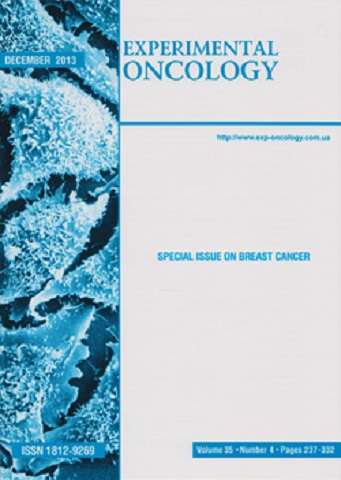CHEMORESISTANCE RELATED TO HYPOXIA ADAPTATION IN MESOTHELIOMA CELLS FROM TUMOR SPHEROIDS
DOI:
https://doi.org/10.32471/exp-oncology.2312-8852.vol-44-no-2.18045Keywords:
chemoresistance, hypoxia, mesothelioma, stemness, tumor spheroidAbstract
Background: Hypoxia has been noted as a key factor for induction and maintenance of cancer stemness thereby leading to therapy resistance. Three-dimensional (3D) spheroid models demonstrate a heterogeneity of hypoxic regions replicating the in vivo situation within tumors. Utilizing an established 3D spheroid model, we investigated whether extrinsic hypoxia reinforced chemoresistance in malignant pleural mesothelioma (MPM) spheroids. Materials and Methods: Tumor spheres were generated from Meso-1 (a typical human MPM cell line) cells having high spheroid-forming ability. To induce hypoxia condition, we utilized a hypoxia chamber with regulation of O2 and CO2 levels. Cell viability was estimated by a WST-8 assay. Real-time polymerase chain reaction and Western blot were performed to evaluate the expression at mRNA and protein levels. Results: Compared with cells cultured in the two-dimensional monolayer model, tumor sphere cells showed elevated mRNA levels of cancer stemness markers (CD26, CD44 and ABCG2) and protein levels of the stemness and hypoxia adaptation markers (ABCG2, ALDH1A1 and HIFs). Correlating with this, 3D spheroid cells were more resistant to permetrexed and topotecan than the two-dimensional cells, indicative of their potential for hypoxic adaptation. Furthermore, significantly stronger resistance to both chemotherapeutic agents was observed in spheroid cells upon hypoxic challenge compared to spheroid cells under normoxia. Conclusion: From the present data, it is concluded that hypoxia adaptation of MPM cells from tumor spheres could enhance their chemoresistance.
References
Yang H, Testa JR, Carbone M. Mesothelioma epidemiology, carcinogenesis, and pathogenesis. Curr Treat Options Oncol 2008; 9: 147–57. https://doi.org/10. 1007/ s11864-008-0067-z
Bibby AC, Tsim S, Kanellakis N, et al. Malignant pleural mesothelioma: an update on investigation, diagnosis and treatment. Eur Respir Rev 2016; 25: 472–86. https://doi.org/10.1183/16000617.0063-2016
Zhao J. Cancer stem cells and chemoresistance: the smartest survives the raid. Pharmacol Ther 2016; 160: 145–58. https://doi.org/10.1183/16000617.0063-2016
Visvader JE, Lindeman GJ. Cancer stem cells in solid tumours: accumulating evidence and unresolved questions. Nat Rev Cancer 2008; 8: 755–68. https://doi.org/10.1038/nrc2499
Wilson WR, Hay MP. Targeting hypoxia in cancer therapy. Nat Rev Cancer 2011; 11: 393–410. https://doi.org/10.1038/nrc3064
Ishiguro T, Ohata H, Sato A, et al. Tumor-derived spheroids: relevance to cancer stem cells and clinical applications. Cancer Sci 2017; 108: 283–9. https://doi.org/10.1111/cas.13155
Lovitt CJ, Shelper TB, Avery VM. Advanced cell culture techniques for cancer drug discovery. Biology (Basel) 2014; 3: 345–67. https://doi.org/10.3390/biology3020345
Kandasamy S, Adhikary G, Rorke EA, et al. The YAP1 Signaling inhibitors, Verteporfin and CA3, suppress the mesothelioma cancer stem cell phenotype. Mol Cancer Res 2020; 18: 343–51. https://doi.org/10.1158/1541-7786. MCR-19-0914
Kaneko S, Sato C, Shiozawa N, et al. Suppressive effect of delta-tocotrienol on hypoxia adaptation of prostate cancer stem-like cells. Anticancer Res 2018; 38: 1391–9. https://doi.org/10.21873/anticanres.12362
Chaicharoenaudomrung N, Kunhorm P, Noisa P. Three-dimensional cell culture systems as an in vitro platform for cancer and stem cell modeling. World J Stem Cells 2019; 11: 1065–83. https://doi.org/10.4252/wjsc.v11.i12.1065
Cortes-Dericks L, Schmid RA. CD44 and its ligand hyaluronan as potential biomarkers in malignant pleural mesothelioma: evidence and perspectives. Respir Res 2017; 18: 58. https://doi.org/10.1186/s12931-017-0546-5
Amatya VJ, Takeshima Y, Kushitani K, et al. Overexpression of CD26/DPPIV in mesothelioma tissue and mesothelioma cell lines. Oncol Rep 2011; 26: 1369–75. https://doi.org/10.1186/s12931-017-0546-5.
Cortes-Dericks L, Carboni GL, Schmid RA, et al. Putative cancer stem cells in malignant pleural mesothelioma show resistance to cisplatin and pemetrexed. Int J Oncol 2010; 37: 437–44. https://doi.org/10.1186/s12931-017-0546-5
Mao Q, Unadkat JD. Role of the breast cancer resistance protein (BCRP/ABCG2) in drug transport — an update. AAPS J 2015; 17: 65-82.
Adjei AA. Pharmacology and mechanism of action of pemetrexed. Clin Lung Cancer 2004; 5: S51-5. https://doi.org/10.1208/s12248-014-9668-6
Kaneko S, Yamazaki T, Kohno K, et al. Combination effect of bowman-birk inhibitor and alpha-tocopheryl succinate on prostate cancer stem-like cells. J Nutr Sci Vitaminol (Tokyo) 2019; 65: 272–7. https://doi.org/10.3177/jnsv.65.272
Shaheen S, Ahmed M, Lorenzi F, et al. Spheroid-formation (colonosphere) assay for in vitro assessment and expansion of stem cells in colon cancer. Stem Cell Rev Rep 2016; 12: 492–9. https://doi.org/10.1007/s12015-016-9664-6
Kanellakis NI, Asciak R, Hamid MA, et al. Patient-derived malignant pleural mesothelioma cell cultures: a tool to advance biomarker-driven treatments. Thorax 2020; 75: 1004–8. https://doi.org/10.1136/thoraxjnl-2020-215027
Simon MC, Keith B. The role of oxygen availability in embryonic development and stem cell function. Nat Rev Mol Cell Biol 2008; 9: 285–96. https://doi.org/10.1038/nrm2354.
Das B, Tsuchida R, Malkin D, et al. Hypoxia enhances tumor stemness by increasing the invasive and tumorigenic side population fraction. Stem Cells 2008; 26: 1818–30. https://doi.org/10.1634/stemcells.2007-0724
Jögi A, Øra I, Nilsson H, et al. Hypoxia alters gene expression in human neuroblastoma cells toward an immature and neural crest-like phenotype. Proc Natl Acad Sci USA 2002; 99: 7021–6. https://doi.org/10.1073/pnas.102660199.
Tong WW, Tong GH, Liu Y. Cancer stem cells and hypoxia-inducible factors (Review). Int J Oncol 2018; 53: 469–76. https://doi.org/10.3892/ijo.2018.4417
Kilic-Fren M, Boylu T, Tabor V. Targeting PI3K/Akt represses hypoxia inducible factor-1α activation and sensitizes Rhabdomyosarcoma and Ewing’s sarcoma cells for apoptosis. Cancer Cell Int 2013; 13: 36. https://doi.org/10.1186/1475-2867-13-36
Pouysségur J, Dyan F, Mazure NM. Hypoxia signalling in cancer and approaches to enforce tumour regression. Nature 2006; 441: 437–43. https://doi.org/10.1038/nature04871
Downloads
Published
How to Cite
Issue
Section
License
Copyright (c) 2023 Experimental Oncology

This work is licensed under a Creative Commons Attribution-NonCommercial 4.0 International License.



